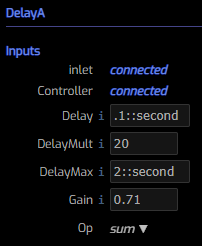/ Examples / Effects / Delays
NoteStreams .. Instruments
Filters .. Effects .. LiCK Effects
Plot .. Utility .. Pure ChucK
Wherein we present various Delay effects.
Right-click to copy examples to your workspace.
Delays
Delay is a foundational audio effect. It is used to achieve effects like Chorus or Flanger. It is also commonly used to achieve Echo effects.
In common use, you will wire the output of the delay back into its input. Normally this is a bad idea but not in this case. When wiring delays into your graphs it's important to take care with Gain.
ChucK/STK offers 3 different delay implementations, each targeting different applications but sharing the same interface parameters.
- Delay a non-interpolating delay, targets short, constant-length delays.
- DelayA an interpolating delay, targets echo effects due to its AllPass frequency response. You can automate the delay to get interesting effects.
- DelayL a linear interpolating delay, targets echo effects but does introduce high-frequency signal attenuation.

Delay controls the current delay period. It must be expressed in ChucK
duration notation, eg 1::second, 10:ms, 400::samp
DelayMult multiplies the value of Delay to produce the final Delay.
The product of these numbers must always be less than DelayMax.
DelayMax specifies an upper limit on the delay and is expressed
in ChucK duration notation.
Gain multiplies the input signal prior to the delay. Remember to keep
an eye on this value especially when you have a feedback loop active.
Bypass allows you to bypass the delay effect.
The Example
This example allows you to explore the behavior of each delay type. The same notestream is deliver to the 3 delay nodes and each feeds into a channel that resides in different stereo positions. Notice that the output of each Delay node is wired into its own input. This is known as a cycle in the graph and you may notice it reported in the Log. This is usually undesirable but here it's exactly what we want. Note that the clean signals are also routed into their associated channel.
Things to try:
- Start the example, then use the Live tab to solo each of the three Channels.
- When a channel is soloed, play with some of its Delay parameters. Remember
that changing the MaxDelay parameter live may produce unpredictable
results. Also note that the DelayAMult node is automating the
DelayMultparameter. - Use the Live panel to start and stop the TimeKeeper.
